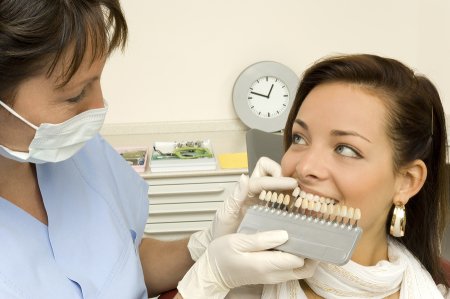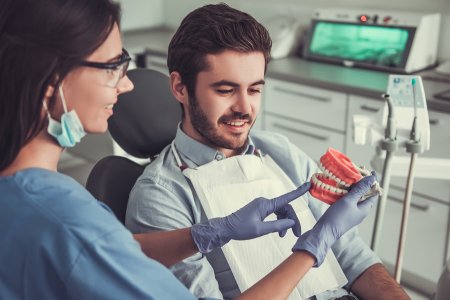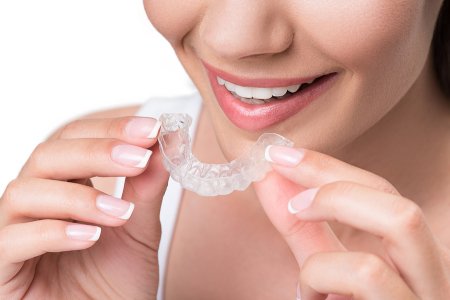-
Do Dental Implants Resist Staining?
If you have missing teeth, dental implants can give you a new smile that looks and feels natural. Although it’s necessary to maintain a good oral hygiene routine when you have dental implants, there is no risk of them becoming decayed, as natural teeth can, but can staining occur?

Generally, tooth staining is not a problem with dental implants, as the glazed finish protects them. This finish can be damaged, however, and when this occurs, implants can become stained. Staining can also happen along the gum line under implants. To protect the finish on your implants, don’t use toothpaste with high levels of baking soda and silica, as they can wear away the surface. If you’re concerned about staining, you can also reduce your intake of foods and drinks that stain natural teeth, including coffee, tea, red wine, and berries.
Glenwood Premier Dental is a leader in implant dentistry in Hazlet , and our dentists will ensure that your implants stay healthy and look great for life. To make an appointment, please call (732) 264-4477.
-
Getting to Know Waterlase
If fear of pain is keeping you away from the dentist and preventing you from getting the restorative care you need, then Waterlase is the answer you’ve been looking for. Waterlase is replacing the drill in many dental procedures, meaning less pain and faster healing times.
Watch this video to see Waterlase in action. Laser dentistry allows procedures that used to involve invasive drilling to be performed with the Waterlase tool instead, so that treating gum disease, tooth decay, and other conditions is virtually painless.
Glenwood Premier Dental is pleased to offer Waterlase as one of our advanced laser dentistry services in Hazlet. Make an appointment the restorative care you need without the discomfort by calling (732) 264-4477.
-
Why Can’t My Dentist Save My Natural Tooth?
If you have an injured, decayed, or loose tooth, your dentist will do everything possible to save your natural tooth. Unfortunately, it’s not always possible, in which case, the tooth will need to be extracted. If you have a tooth extracted, restorative care , including dental implants, can make your smile complete again. Here are some of the reasons that your dentist may be unable to save your natural tooth.

Infection
If an infection occurs in the pulp of your tooth, it may need to be removed. This kind of infection typically occurs when bacteria from decay in another part of the tooth enters the pulp. If you have such an infection, your dentist may first try to perform a root canal, in which the infected pulp is removed and the tooth is then sealed. However, if the infection is too large to be effectively treated with a root canal, or if you have a compromised immune system that makes a tooth infection dangerous, it may be necessary to extract the tooth instead.
Gum Disease
Gum disease is one of the most common reasons natural teeth are extracted. If gum disease is not treated in its early stages, it can damage the root, connective tissue, and bones the support the teeth. When this occurs, teeth become loose, and it becomes necessary to remove them.
Trauma
When injuries occur that damage a tooth beyond repair, then your dentist will need to remove it. This can occur as the result of a sports injury, car accident, or other traumatic event in which your teeth are impacted. Although your dentist will first make an effort to save your tooth, removal may be the only option.
At Glenwood Premier Dental, we offer extensive restorative care services in Hazlet, including crowns and dental implants. Whether you need care to save a tooth or cosmetic dentistry to restore your smile, our state-of-the-art office has the advanced treatments you need. Call us today at (732) 264-4477 to make an appointment.
-
Your First Week with Invisalign
If you’ve made the decision to improve your smile with Invisalign , then you’re probably curious about what the adjustment period will be like. Most people who use Invisalign find the aligners to be comfortable and easy to wear—much less obtrusive than traditional metal braces. As you begin your journey to a new smile, here is what you can expect during your first week of Invisalign treatment.
Adjusting to the Feel
When the aligners are first snapped onto your teeth by your dentist, you may notice that they feel a little snug. They have to fit your teeth tightly in order to make the shifts that are required for your treatment plan and to ensure that they don’t move when you speak. Although patients often describe noticing the snugness at first, the sensation tends to go away very quickly. Within a few hours, you likely won’t even notice that they are there.

Speaking with the Aligners
When you speak, you’ll feel the aligners at first, so you may feel like your speech is changing or that you are lisping. This temporary effect also goes away very quickly, once you become used to the sensation of the trays and how it feels when your tongue touches them when you talk. It’s normal to feel self-conscious about the way you’re speaking at first, but soon it will feel completely natural and you’ll feel like you’ve reverted to your normal speech.
Eating and Aligner Removal
Once of the benefits of Invisalign is that you remove the aligners when you eat, so you don’t have to worry about avoiding certain foods or staining the trays. At first, it may be challenging to remove the aligners, but soon the technique will be second nature. As you adjust, the biggest challenge may be remembering to remove them, since you’ll forget they are there.
At Glenwood Premier Dental, we’ll walk you through each step of the Invisalign treatment process, so you can focus on getting a smile you’ll love to show off. Could Invisalign be right for you? Schedule an appointment with one of our dentists in Hazlet today by calling (732) 264-4477.
